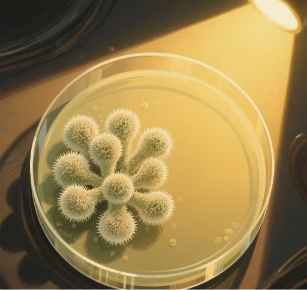Amid mounting global concerns about environmental degradation and food security, China’s agricultural industry is undergoing a transformative shift towards more sustainable and eco-friendly practices. Trichoderma is at the forefront of this movement. Hailed as the “invisible superhero” of modern agriculture, this microscopic powerhouse is revolutionizing China’s farming landscape. Trichoderma is known for its biocontrol prowess, growth-boosting capabilities, and soil-restorative properties. Trichoderma-based biofertilizers are reshaping China’s farming landscape. However, significant challenges lie ahead in terms of technological adaptation, market acceptance, and regulatory hurdles. Overcoming these challenges is essential to unlocking its full potential.
The Rise of Trichoderma: From Microbe to Market Phenomenon
China’s microbial fertilizer sector has grown remarkably, expanding from around 100 companies in the 1990s to more than 2,000 today. Among these companies, Trichoderma has emerged as a key player. Experts like Professor Jiang Xiliang of the Chinese Academy of Agricultural Sciences (CAAS) recognize Trichoderma as one of the top three globally recognized biocontrol microbes. Its applications span multiple facets of agriculture.
- Biocontrol agents: Trichoderma suppresses pathogens through mechanisms such as competition, parasitism, and induction of systemic resistance (ISR) in plants.
- Biofertilizers: It enhances nutrient absorption, breaks down agrochemical residues, and revitalizes degraded soil.
- Biostimulants: Trichoderma produces phytohormones, such as indole-3-acetic acid (IAA) and gibberellins, which boost crop growth and resilience.
While its advantages are compelling—improving long-term soil health without the risk of resistance (as noted by Professor Chen Jie of Shanghai Jiao Tong University) and providing systemic plant protection—limitations exist. Unlike chemical fertilizers or pesticides, Trichoderma’s effects are slower, necessitating early application during soil preparation.
Navigating Species Diversity and Product Homogeneity
Despite its growing adoption, China’s Trichoderma market faces challenges related to diversity and product innovation. As of 2024, 618 Trichoderma-based biofertilizers are registered (including expired registrations), with T. harzianum dominating at 75.24%, followed by T. longibrachiatum, T. asperellum, and T. viride. Key market leaders, such as MuEn Bio (with 11 registrations), Shanghai Dajing Bio, and Kingenta, are driving progress. However, product homogeneity arises from the reliance on common species and the limited use of rare strains. Additionally, the majority of formulations are powders (493 products), granules (102), and liquids (23), though innovations like MuEn’s upcoming oil-based dispersions offer hope. Synergistic combinations with Bacillus spp. (e.g., B. subtilis) show promise, but they face hurdles in production and storage.
Barriers to widespread adoption
The widespread adoption of Trichoderma-based biopesticides faces significant challenges, primarily due to technical obstacles and user difficulties.
Technical Hurdles:
- Shelf Life: Live products have a shelf life of only 3–6 months, with spore viability declining sharply (3–5 log reductions in 6 months). Microencapsulation and vacuum packaging only provide limited relief.
- Field Instability: Efficacy fluctuates due to soil salinity, UV exposure, and chemical interactions.
- Formulation complexity: Poorly understood interactions between Trichoderma and additives hinder optimization.
User Challenges:
- Farmers often overapply or misuse products due to a lack of knowledge about optimal timing, dosages, and compatibility with agrochemicals.
- Misleading marketing claims generalize efficacy without providing crop-specific protocols.
- Quality control: Substandard products with low spore counts or undeclared chemicals undermine trust despite regulatory efforts.
Paving the Way Forward: Innovation and Collaboration
The future hinges on targeted advancements.
- Metabolite engineering: Leveraging Trichoderma’s primary metabolites (nutrient-rich sugars and amino acids) and secondary metabolites (antimicrobial peptides and siderophores) for disease control and soil remediation. Products like Dajing Bio’s “Bimiao” (which is compatible with herbicides) and Jinyufeng’s “Liukangsu” demonstrate this potential.
- Specialized Solutions: Crop-specific formulations, such as seed coatings for cereals and root inoculants for vegetables, as well as synthetic microbial consortia, like Trichoderma-Bacillus blends, show promise.
- Policy and Education: Government support for R&D, standardization, and farmer training programs is crucial. Clear protocols and tailored application techniques will bridge knowledge gaps. For example, over 50% of surveyed farmers reported improved yields after participating in regional training programs piloted by MuEn Bio.
Conclusion: A Cornerstone of Future Farming
Trichoderma biofertilizers are here to stay. They represent a cornerstone of China’s sustainable agricultural future. Although technical and adoption barriers persist, advancements in metabolite science, formulation innovation, and collaboration between industry, academia, and policymakers will solidify their dominance. As the world moves towards more sustainable practices and reduces its reliance on chemicals, Trichoderma’s multifaceted benefits align perfectly with China’s ambition to lead in green agriculture. Overcoming current challenges will allow Trichoderma to truly become the “invisible superhero” that can revolutionize farming worldwide.









